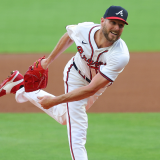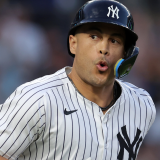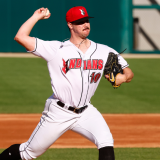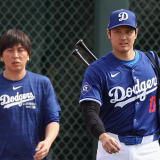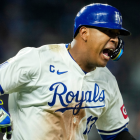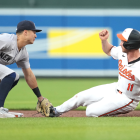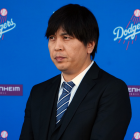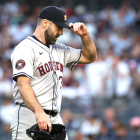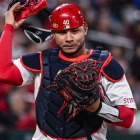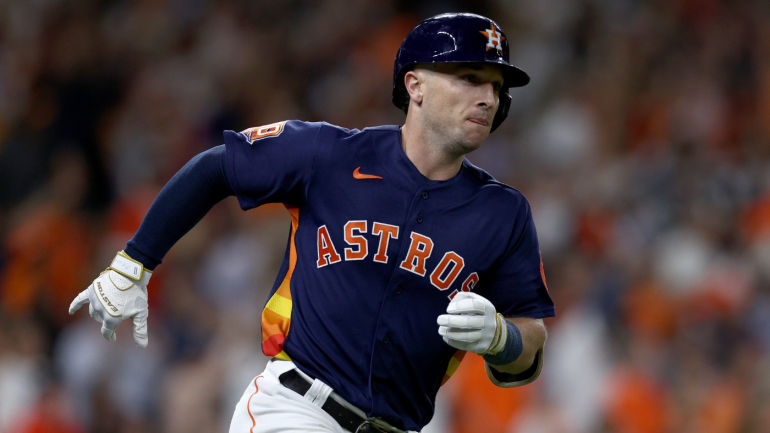
Spring training is roughly four weeks away and we are in the dog days of the offseason. Only four of our top 50 free agents remain unsigned and none rank among the top 25. It was a strong free agent class, one particularly deep in high-end position players, and it would have been even stronger had several players not opted for long-term security early in their careers.
These days, many young players sign long-term contract extensions that push back their free agency. They trade their maximum earning potential through arbitration and free agency for financial security early in their careers. I don't blame them one bit. I'd do the same thing. It does, however, mean these players aren't hitting free agency when expected, taking a bite out of the offseason.
It takes six years of service time to quality for free agency, but given the way teams manipulate service time, it often takes closer to seven years. Sean Manaea, for example, would have been a free agent last offseason had the Athletics put him on their Opening Day roster in 2016. Instead, they kept him down until late April, pushing his free agency back. Manaea was much better in 2021 than 2022 (plus he was a year younger) and would have been better positioned to land a significant free agent payday last winter.
Twenty players reached the six years of service time necessary to qualify for free agency after the 2022 season but had already signed extensions early in their careers. Here they are ranked in a fantasy world where they hit the market this offseason anyway.
| 1 |
Alex Bregman
Houston Astros 3B
|
Contract: 5 years, $100 million (signed March 2019) The Astros have developed several elite players in the last decade but they've been selective with extensions. Carlos Correa and George Springer did not receive long-term deals and were allowed to leave as free agents while others like Bregman, Yordan Alvarez, and Lance McCullers Jr. were locked up. Bregman signed his extension coming off a fifth place finish in the AL MVP voting in 2018, and right before a 41-homer effort in 2019 made him the AL MVP runner-up. Houston's sign-stealing scandal did not cost Correa and Springer in free agency (Correa's free agent stock was hurt by his medicals, not the sign-stealing scandal), so there's no reason to think Bregman would have suffered this offseason. His blend of power, on-base ability, and top of the line defense at a prime age (29 in March) would have made him an extremely attractive free agent. Even with Bregman set to make $28.5 million in actual salary in 2023 and again in 2024, the Astros secured themselves a major bargain with this extension. What would he get this offseason? A superlong contract along the lines of Xander Bogaerts (11 years and $280 million) and Trea Turner (11 years and $300 million) would have been in play for Bregman this winter. He is in that class of player and still on the right side of 30. | |
| 2 |
Byron Buxton
Minnesota Twins CF
|
Contract: 7 years, $100 million (signed November 2021) What a fascinating free agency this would have been. Buxton is a dynamic talent, truly one of the most electrifying players in the game, but injuries continue to hamper him. In 2022, knee and hip injuries limited Buxton to 92 games, and he's played only 279 of 546 possible regular season games the last four years, or 51 percent. Buxton is an MVP caliber performer when healthy (150 OPS+ and 8.6 WAR in 153 games the last two years). He just isn't healthy often enough. The injury risk is baked into Buxton's extension -- bonuses and incentives can push the total value up close to $200 million -- but yeah, it would have been an adventure to see how teams would have valued him on the open market. What would he get this offseason? I think pretty much exactly what is remaining on his contract, six years and $91 million with a mountain of incentives. This free agent class was thin on above-average everyday center fielders (Brandon Nimmo was the only one available), so perhaps I'm underselling Buxton. Still, another injury-plagued season in 2022 would have hurt his free agent stock. At this point you can't assume Buxton is anything more than an 80-ish games per year player, and the free agent offers would have reflected that. | |
| 3 |
Tim Anderson
Chicago White Sox SS
|
Contract: 6 years, $25 million plus two club options (signed March 2017) The White Sox wasted no time locking up Anderson's services. They gave him this six-year contract following his partial rookie season in 2016 (partial because he wasn't called up until June) and he's now among the best bat control artists in the game, leading baseball with a .318 batting average the last four seasons. Anderson isn't perfect -- his low walk rate keeps in his on-base percentage down and he can be error-prone at shortstop -- but getting a simple base hit is very hard these days because pitchers are so good and teams can optimize their defensive alignments (we'll see about those new shift rules). Anderson gets hits as well as any player in the game. His high contact bat makes him a uniquely valuable player despite other shortcomings. What would he get this offseason? Anderson is a notch below this offseason's elite shortstops (Carlos Correa, Trea Turner, etc). Could he have gotten a deal more in line with the six-year, $140 million contracts Javier Báez and Trevor Story signed last offseason? I think so, though those deals are cautionary tales now. Anderson turns 30 in June. I think his floor would have been five years at $18 million per year, or thereabouts. That's a bit above what the White Sox gave Andrew Benintendi, another bat control wizard with shortcomings elsewhere in his game (lack of power, non-premium position, etc.). | |
| 4 |
Joe Musgrove
San Diego Padres SP
|
Contract: 5 years, $100 million (signed August 2022) Musgrove, a San Diego native, signed his extension roughly three months prior to being no worse than the fourth best available free agent starter, and the best without concerns about age (like Justin Verlander) or injury history (like Jacob deGrom and Carlos Rodón). It's hard to turn down $100 million, but usually when players get as close to free agency as Musgrove, they see what the open market has to offer. And given the free agent contracts we saw this offseason, Musgrove's deal is already a bargain for the Padres. Tremendous value for a tremendous pitcher, one who's really come into his own in his hometown. What would he get this offseason? Rodón's six-year, $162 million contract might've been in play. Musgrove was not quite as dominant as Rodón last season in terms of strikeouts and preventing home runs, but he was excellent, and he has a much cleaner injury history. Plus they're almost exactly the same age (Musgrove is six days older). Last offseason's Kevin Gausman (five years and $110 million) and Robbie Ray (five years and $115 million) contracts would have been Musgrove's floor, I think. | |
| 5 |
Ketel Marte
Arizona Diamondbacks 2B
|
Contract: 5 years, $76 million plus one club option (signed March 2022) The Diamondbacks have already extended Marte twice. They gave him a five-year, $24 million extension with two club options in May 2018, the first of which would have hit in 2023. They then signed Marte to this new five-year extension last spring, ripping up the two club options on the previous deal and covering 2023-27, with club options for 2028 and 2029. Injuries have held Marte back a bit the last few years, but a just-turned 29-year-old switch-hitter with contact skills and power at an up-the-middle position would have been a hot commodity in free agency. What would he get this offseason? The matching six-year, $140 million contracts Javier Báez and Trevor Story received last offseason are about right. The x-factor would have been whether any teams believe Marte can play center field. He manned second base exclusively in 2022, and the D-Backs moved him out of center late in 2021 because a) they're loaded with outfield prospects, and b) Marte kept hurting his hamstring, and running around so much wasn't a great idea. This was a thin center field market. All it would have taken is one team believing in Marte as a center fielder to raise his price. | |
| 6 |
Jorge Polanco
Minnesota Twins 2B
|
Contract: 5 years, $25.75 million plus two club options (signed February 2019) Polanco can be a confusing player. There are stretches where he plays like a bona fide star, like the second half of 2021, and also stretches where he's just average-ish and leaves you wanting more, like the second half of 2022. The truth is somewhere in the middle and that truth is an above-average switch-hitter with power, but not exactly game-changing defense at second base. Statcast's defensive stats say Polanco's range is lacking, making him a bit of a question with extreme infield shifts now outlawed. Second base range is at a premium and Polanco doesn't really have it. Surely teams know that. What would he get this offseason? The big shortstop contracts handed out the last two offseasons would have been well out of reach for Polanco, who turns 30 in July. Something along the lines of Chris Taylor's four-year, $60 million deal might have worked, though Polanco now is two years younger than Taylor was last offseason, so his camp could have reasonably sought a fifth year, possibly even a sixth. | |
| 7 |
Blake Snell
San Diego Padres SP
|
Contract: 5 years, $50 million (signed March 2019) As is often the case, the Rays signed a player to a long-term extension, then traded him away a few years later. In this case it was two years later, and now Snell is entering his third season with the Padres and fifth year of his five-year contract. He is a tantalizing yet frustrating pitcher, one with Cy Young upside but also one liable to throw 100 pitches in four innings. Snell turned 30 last month and power lefties with hammer breaking balls will get chance after chance after chance. He is the kind of pitcher every team looks at and says "we can fix him." What would he get this offseason? In terms of free agent stock, Snell would have been a 'tweener this offseason, ranking behind aces like Jacob deGrom, Carlos Rodón, and Justin Verlander, and ahead of second tier starters like Tyler Anderson and Taijuan Walker. I think a deal in the four-year, $80 million range would have worked. Then again, Walker received a four-year deal worth $72 million at roughly the same age, and he has a much longer injury history without the demonstrated Cy Young upside. Perhaps a $100 million deal would have been out there for Snell. | |
| 8 |
Germán Márquez
Colorado Rockies SP
|
Contract: 5 years, $43 million plus one club option (signed April 2019) Márquez is the quintessential "get him out of Coors Field and he could be great" Rockies pitcher. Adjusted for ballpark and the league's offensive environment, Márquez has been about 10 percent better than average since 2017, his first full MLB season. And, of course, he has a 5.16 ERA and a .792 opponent's OPS at home during that time. On the road, those numbers are 3.66 and .687, respectively. Márquez has flashed premium bat-missing stuff throughout his career, he turns only 28 next month, and he almost never misses a start. He would have been a coveted free agent. What would he get this offseason? There is reason to believe Márquez would be better -- a lot better -- outside Coors Field, but teams don't know that for certain, and that uncertainty would have been reflected in the offers. Last offseason Jon Gray, another one of those "get him out of Coors Field and he could be great" pitchers, signed a four-year deal worth $14 million per year. Márquez now is two years younger than Gray was last offseason though, and he has a much cleaner injury history. His camp might have pushed for five years and upwards of $18 million per season with an opt out after Year 1 and/or Year 2, allowing Márquez to give free agency another go just in case his performance dramatically improves outside Denver. | |
| 9 |
José Berríos
Toronto Blue Jays SP
|
Contract: 7 years, $131 million (signed November 2021) Without the extension, Berríos would have had a career worst season at exactly the wrong time. His fastball got hammered in 2022, and the result was the highest ERA among qualified starters (5.23) and his lowest strikeout rate (19.8 percent) in a full season. His value has always been tied up in eating innings at a reliably above-average but not truly elite rate, then it all fell apart in what would have been his contract year. Berríos is still only 28 and starting pitching is always in demand, so it's not like he would have had much trouble finding a job this winter. He just would not have been quite as desirable as expected going into 2022. What would he get this offseason? I think Berríos would have been a prime candidate to accept the $19.6 million qualifying offer this winter, assuming the Blue Jays offered it. Take the high-salaried one-year deal, rebuild value in 2023, then give free agency another try next offseason, when he would still be only 29. Berríos has six years and $121 million remaining on his deal and is the first player in these rankings I am comfortable saying is better off with his extension than with the free agent contract he would have received this winter. | |
| 10 |
Luis Severino
New York Yankees SP
|
Contract: 4 years, $40 million plus one club option (signed February 2019) It's almost comical how quickly this extension turned sour for the team. The Yankees signed Severino on Feb. 15. He was shut down with a sore shoulder on March 5. A lat strain followed, then Tommy John surgery, then a groin strain. From 2019-21, the first three years of the four-year extension, Severino threw 27 2/3 MLB innings, postseason included. Severino had more lat trouble in 2022, though he did throw 102 innings and was very good when healthy, and he received AL Cy Young votes in 2017 and 2018. Clearly, Severino made out well with his extension. The injuries would have sabotaged his earning potential through arbitration and may have even led to a non-tender. What would he get this offseason? Severino turns 29 in February and was healthy enough last year to entice teams this offseason, but the scary arm injury history would have limited the offers. He might have gotten something like the contract the Giants gave Carlos Rodón last offseason, a two-year deal worth $44 million with an opt out. The two-year term limits risk for the team and the opt out would have given Severino a chance to test free agency again next winter in the event he stayed healthy and pitched well, which is how it played out for Rodón. | |
| 11 |
Manuel Margot
Tampa Bay Rays RF
|
Contract: 2 years, $19 million plus one club option (signed April 2022) This was a bad offseason to need a center fielder and the Rays got out ahead of the market by signing Margot to a two-year deal last April. Margot has mostly played the corner outfield spots in deference to Kevin Kiermaier, but he can play center field, and Tampa surely knew they were declining Kiermaier's $13 million club option when they extended Margot. They now have Jose Siri to man center, but Margot is a gifted defender and a league-average hitter with a history of pounding lefties. He would have been in demand in a free agent market that was devoid of quality center fielders beyond Brandon Nimmo. I may have Margot too low in these rankings. What would he get this offseason? Margot will play just about the entire 2023 season at age 28 and would have been in line for a four- or five-year deal despite a knee injury that limited him to 89 games in 2022. Four years at $53 million is Avisaíl García's contract with the Marlins and Margot is both several years younger and more consistent year-to-year than García. | |
| 12 |
Max Muncy
Los Angeles Dodgers 3B
|
Contract: 1 year, $13.5 million plus one club option (signed August 2022) This is Muncy's second extension with the Dodgers. He signed a three-year, $26 million deal with a $13 million club option back in February 2020. This new extension locked in that club option year with a slight pay bump, and tacked on another club option for 2024. Muncy turned 32 in September and he had a down year at the plate in 2023, plus the upcoming ban on extreme infield shifts may compromise his ability to play second base since it'll put a premium on range. Still, 30-homer power and one of the highest walk rates in the league will never go out of style. What would he get this offseason? Something like Josh Bell's contract with the Guardians might have been the benchmark for Muncy. Bell received a two-year, $33 million deal with an opt out. The harshest evaluation of Muncy's 2023 season could have led to a one-year deal in the $10 million range, which is the contract the Dodgers gave Muncy's new teammate J.D. Martinez. | |
| 13 |
Daniel Bard
Colorado Rockies RP
|
Contract: 2 years, $19 million (signed July 2022) Remember when the Rockies, who were 10 games out of a postseason spot the morning of the trade deadline, opted to extend Bard rather than trade him? That was weird. Good for Bard though. His comeback has been remarkable. He didn't play from 2018-19 and was working in player development with the D-Backs when he decided to attempt the comeback, and he's been among the game's most effective relievers the last three seasons. In 2022, Bard saved 34 games with a 1.79 ERA in 60 1/3 innings, and he secured the largest contract of his career. Awesome stuff. What would he get this offseason? The contract he signed. Bard is 37, so he's not young, though he has fewer miles on his arm than most 37-year-olds given his unusual career path. Two years and $19 million is a bit more than what Adam Ottavino (two years and $14.5 million) and Matt Strahm (two years and $14 million) received this winter. Perhaps Bard could've pushed it up to $20 million on open market, but yeah, the extension works as a free agent contract. | |
| 14 |
Max Kepler
Minnesota Twins RF
|
Contract: 5 years, $35 million plus one club option (signed February 2019) One of the hardest to figure out players in baseball, Kepler turns 30 next month, though he feels younger, and for most of his career you could pencil him in for slightly below-average offense. The exception is 2019, the year of the home run, when he mashed 36 taters. Kepler plays excellent defense in right field and doesn't strike out much, and there's reason to believe he will benefit from the upcoming limitations on extreme infield shifts. How much will he benefit, exactly? Hard to say, but Kepler has posted a historically low batting average on balls in play in his career. With more than 3,300 career plate appearances under his belt, we have to assume that is his true talent level, not a fluke. What would he get this offseason? This is a tough one. Kepler is good enough defensively to play center field and this free agent class was short on quality center fielders. You could also talk yourself into him having untapped potential with extreme shifts going away. Would a team do three years at $14.5 million a year? That is Mitch Haniger's new contract. | |
| 15 |
Whit Merrifield
Toronto Blue Jays 2B
|
Contract: 4 years, $16.25 million plus two club options (signed January 2019) Merrifield was a late bloomer who didn't play his first full MLB season until age 28, and his career has followed a traditional aging curve perfectly. He peaked with All-Star caliber seasons in 2018 and 2019, his age 28 and 29 seasons, and he's gradually declined since entering his 30s. That isn't to say he's bad now, just that he's a solid role player more than a centerpiece at this point. I should note Merrifield and the Royals restructured his extension last April, essentially shifting money from 2023 to 2022 to spread it out more evenly. What would he get this offseason? Merrifield turns 34 later this month and teams undoubtedly would have been attracted to his versatility. A one-year contract around $8 million might've been the move here. That's the contract the Orioles gave Adam Frazier. Under the terms of his restructured contract, Merrifield will make $6.75 million in 2023. | |
| 16 |
Richard Bleier
Miami Marlins RP
|
Contract: 2 years, $6 million plus one club option (signed March 2022) Very quietly, Bleier has been one of the game's steadiest relievers over the last half-decade, pitching to a 3.16 ERA with a ground ball rate north of 60 percent since 2017. He did not make his MLB debut until age 29 and it was not until his age 30 season that he spent a full year in the big leagues, but he's been chugging along since, getting ground ball after ground ball. The elite ground ball ability would have made Bleier a sneaky hot commodity in free agency this winter. What would he get this offseason? Bleier turns 36 in April, so he carries age-related risk, but his ground ball dominance likely would have landed a nice little multi-year guarantee. Figure two years and $10 million or so, along the lines of the contracts Collin McHugh and Brooks Raley signed last winter. | |
| 17 |
Austin Barnes
Los Angeles Dodgers C
|
Contract: 2 years, $7 million plus one club option (signed July 2022) As far as backup catchers go, it's hard to do much better than Barnes. He can put a mistake in the seats, he draws walks, and he rates very well as a pitch-framer and as a defender overall. Clayton Kershaw recently called Barnes "our captain," and it's good to have the franchise legend in your corner. Barnes produces well relative to other backup catchers and he has value as a clubhouse leader. What would he get this offseason? Given the dearth of quality catchers around the league, the 33-year-old Barnes might have been able to snag a contract along the lines of Omar Narváez's deal with the Mets (two years, $15 million). More likely, his current contract is about right. Manny Piña got two years and $8 million to be a backup catcher last winter, for reference. | |
| 18 |
Max Stassi
Los Angeles Angels C
|
Contract: 3 years, $17.5 million plus one club option (signed March 2022) Stassi hit 13 homers with great pitch-framing numbers in 2021, prompting the Angels to sign him to that extension. Then his game completely collapsed in 2022. He slipped from .241/.326/.426 in 2021 to .180/.267/.303 in 2022, and he went from rating as one of the game's best pitch-framers to merely average. For all intents and purposes, Stassi was replacement level in 2022, and the Angels are set to move him into the backup role with prospect Logan O'Hoppe, who was acquired in the Brandon Marsh trade with the Phillies, poised to take over as the starter. What would he get this offseason? Decent catchers are hard to find and more than a few teams would have pursued Stassi with the hope 2022 was just a bad year, and 2021 is closer to the real him. The Cubs gave Tucker Barnhart a two-year deal worth $6.5 million a few weeks back. That sounds about right for Stassi. Financially, he came out ahead with the extension. | |
| 19 |
José Leclerc
Texas Rangers RP
|
Contract: 4 years, $14.75 million plus two clubs option (signed March 2019) I may have Leclerc too low in these rankings. He just turned 29 and is coming off a 2.83 ERA season with 54 strikeouts in 47 2/3 innings, though a shoulder injury and Tommy John surgery limited him to only two innings total from 2020-21. Leclerc returned from elbow reconstruction last June and stayed healthy the rest of the year, showing his old velocity even if his strikeout rate dipped. As a free agent, he would have been viewed as a potential upside play who could get better and be more consistent as he gets further away from Tommy John surgery. What would he get this offseason? Carlos Estévez, a similar hard-throwing righty signed for his upside, netted a two-year deal worth $13.5 million last month. In Estévez's case, the upside is tied to getting out of Coors Field. With Leclerc, it's health. The Rangers picked up Leclerc's $6 million club option earlier this winter and his 2024 club option will pay him $6.25 million, so that's $12.25 million total from 2023-24, not far below Estévez's deal with the Halos. | |
| 20 |
Elias Díaz
Colorado Rockies C
|
Contract: 3 years, $14.5 million (signed November 2021) Díaz, now 32, slugged 18 homers with average pitch-framing and overall solid defense in 2021, so the Rockies gave him a three-year extension. Decent catchers are hard to find and Díaz looked to be exactly that. He then hit half as many homers in the same number of plate appearances in 2022, and posted dreadful defensive stats. At a position where the bar is basically on the floor, Díaz was a minus-1.5 WAR player in 2022. Yeesh. Worst of all, 2021 is the outlier in Díaz's career, not 2022. Last year was his third season with at least minus-1.0 WAR. What would he get this offseason? A minor league contract with an invitation to big league spring training, which is how Colorado originally acquired Díaz four years ago. I know I've said decent catchers are hard to find about a thousand times in this post, but there is scant evidence Díaz is even that. No chance he'd come close to matching his extension in free agency, let alone beat it. Great work by his agent. | |



























